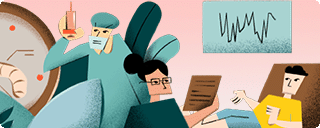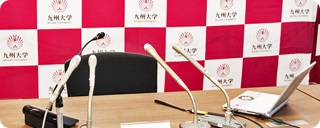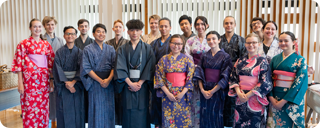研究・産学官民連携 Research
Light at night and the internal circadian clock: Is your clock affected by bright nights?
- TOP
- Research
- Research at Kyushu University
- Art and Design
- Recent Studies at the Faculty of Design
- Recent studies at the Faculty of Design in 2017
- Light at night and the internal circadian clock: Is your clock affected by bright nights?
Research Projects and Initiatives
Recent Studies at Faculty of Design
Light at night and the internal circadian clock: Is your clock affected by bright nights?
By Professor Shigekazu Higuchi,
Faculty of Design and Physiological Anthropology Research Center and Center for Designed Futures of Kyushu University
■Research background
If you join together satellite images of the earth at night, you can create a map of the world drawn in light. Nighttime illumination is necessary for our everyday peace of mind. However, recent research has indicated that bright nights may negatively affect our sleep and circadian clock. At our laboratory, we research the effects of light on the human body in order to design light environments that are healthy and human-friendly.

Lights around the world at night. Satellite photograph. Japan is visible at the far right. Even in Asia, Japan is particularly bright. (Photograph from Wikipedia).
■What is a circadian clock?
The circadian clock is a kind of internal clock, centered in the hypothalamus in your brain, which measures off cycles of approximately one day’s length. The circadian clock also plays a role in aligning the internal rhythms with the daylight cycle created by the rotation of the Earth. Light that enters the eye is transmitted to the brain, affecting the circadian clock along a path (the dotted line in the left region of the diagram below) that is separate from those of perception of brightness and color. In our research, we investigate the effects of light, utilizing the fact that the production of melatonin, a hormone secreted only at night, is suppressed by light exposure (diagram right).

Two routes of the nerve conduction of light and their effects (from the Annual Report of Physical and Mental Health among the Children in 2015, in Japanese).
■Light produces stronger effects in children than adults
Does light affect everyone equally? We investigated the effect of light on melatonin secretion in both adults and children. Surprisingly, we found that children are twice as affected by light as adults are. When children were placed in experimental settings of about the same brightness as a convenience store, melatonin secretion was almost entirely suppressed. We recently investigated the circadian clocks of children participating in a children’s camp (hosted by Hello Woods) lasting 31 days and 30 nights(in Japanese) in an environment with almost no artificial light.

Research environment for the testing of the effects of white fluorescent light (left) and effects on melatonin (right). Arrows pointing downward indicate magnitude of effect. Taken and adapted from the article below.
Higuchi et al. (2014). Influence of light at night on melatonin suppression in children. J Clin Endocrinol Metab, 99(9), 3298-3303 (PDF free)

The Child Leaders Summer Forest Camp (in Japanese). 31-day 30-night camp. We investigated the sleep and circadian clocks of children participating in this camp held in nature with little artificial lighting.
■Light for people working at night
Night shifts and alternative work schedules disturb the circadian rhythm and sleep. Although light is necessary for nighttime work, that same light ironically increases risks to worker health. In our laboratory, we scientifically test the effects of working under nighttime light in order to protect workers from negative health effects. In a recent joint research effort with the Japan Aerospace Exploration Agency (JAXA), we have conducted research on illumination within the control room, an environment which operates on a 24-hour work schedule.


Our research into the efficacy of naps for nighttime workers was featured in NHK’s Close-up Gendai “The ‘body clock’ changes medical care (In Japanese)” Experiment location (left) and a photograph of the filming (right). Experiment conducted at an artificial environment at the Faculty of Design’s Research Center for Human Environmental Adaptation.
■There are photosensitive cells other than rods and cones!
We know that the effect of light on the circadian clock is strong when carried through blue light. This is due to the existence of retinal ganglion cells containing a type of photoreceptor known as melanopsin. These cells, discovered just before the year 2000, shocked the world. These photosensitive cells convey information about light to the circadian clock. At our laboratory, we conducted research focusing on polymorphic genetic differences in melanopsin in different individuals. To put it simply, we found that response to light differs if the protein blueprint is different (Higuchi et al., 2013; Lee et al., 2013). Part of this content was featured in Kyushu University’s promotional publication New Challengers (published November 2012, in Japanese).

The article of melanopsin study in our Lab.(This study was conducted by Dr. Lee)
■A research topic of endless interest
First Edison discovered the incandescent electric lightbulb, then came the rapid spread of fluorescent lighting, and finally in the near future these may be replaced by new lighting such as LED or OLED illumination. Although technological development continues to progress, there is still much we do not know about the effects on human. By investigating the connection between light and the circadian clock through basic scientific research, we hope contribute to the design of healthy lifestyles and light environments.
■Literature cited
Those seeking further information may consult the review articles below.
Higuchi S, Lee SI (2015) Light circadian rhythm and individual differences in its effects on melatonin secretion. Journal of Light and Visual Environment. 99(1), 22-24(PDF in Japanese).
Higuchi S (2011) Nonvisual effects of light - adjusting to light environments. Journal of the Japan Society of Physiological Anthropology 15(1), 21-26(PDF in Japanese).
■Inquiries
Faculty of Design and Department of Human Science
Professor Shigekazu Higuchi (Home Page)
- TOP
- Research
- Research at Kyushu University
- Art and Design
- Recent Studies at the Faculty of Design
- Recent studies at the Faculty of Design in 2017
- Light at night and the internal circadian clock: Is your clock affected by bright nights?































